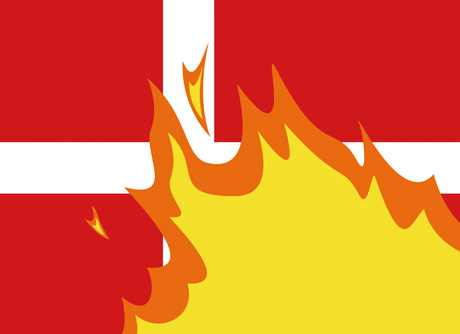Superflex and the Re-branding of Denmark
Mats Bigert

In February 2006, the Danish embassy in Damascus was attacked by a furious mob, which set it on fire using the offices’ own furniture. The hatred in the Islamic world toward Denmark following the publication in Jyllands-Posten of the caricatures of the prophet Mohammed had spilled over; the embassy of Norway, one of whose newspapers had reprinted the caricatures, was also torched by Syrian protestors. All Scandinavian countries with a cross on their flag, it seemed, were suddenly vulnerable. But when the mob went from torching embassies to burning flags, it only saw red—the predominant color of the Danish flag. The Lilliputian country of Hans Christian Andersen was under attack, and the xenophobia encouraged by the nation’s right-wing government had come back to bite the Danes.
But the burning Danish flags seen on the news for weeks didn’t just raise questions of a religious or ideological nature. There were also some practical questions, such as: Where did all the flags come from? Surely Middle Eastern flag factories had not been hoarding a surplus of Danish flags. A closer study of some prime-time desecrations showed that most of the flags were in fact poor DIY replicas, with uneven lines, off-kilter crosses, and only an approximation of Denmark’s trademark red. Luckily for the DIYers, the Danish flag is one of the easiest to copy—a white sheet and some red household paint will do the job. If Norway’s flag had been the main target, its third color would have made for a somewhat more complex task, and the number of public desecrations might have been reduced. Ironically, it is legal in Denmark to burn the “Dannebrog,” as their flag is called, but not the flags of other nations. The reasoning behind this curious law is that burning a foreign flag is a matter of foreign policy insofar as it might be construed as a threat to the other nation.
In their project Re-branding Denmark, the Danish artist collective Superflex asks whether this national trauma could be turned into a productive discourse. Is it possible to extract new meaning from the graphic image of the burning Danish flag? What are the consequences for a small, slumbering nation to be drawn into the maelstrom of international politics? Will the new graphic symbol be a brand of shame to be held up for coming generations, or can a re-branded national symbol, boasting a cool custom flamejob, be viewed as a radical statement of newly gained political awareness?
Mats Bigert is an editor-at-large of Cabinet and one half of the Swedish artist duo Bigert & Bergström. Life Extended, their new film on the utopian quest for immortality, will have its world premiere at the “Documentary Fortnight” at the Museum of Modern Art, New York, in February 2009.